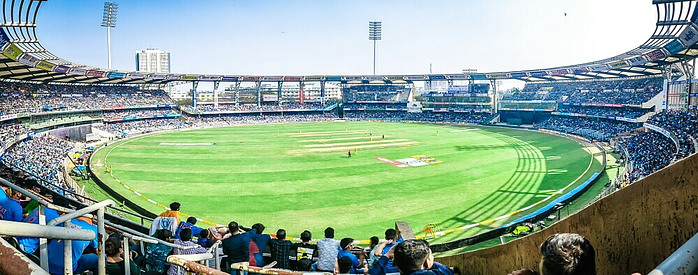Explaining cricket … really? Explaining a sport that is both so simple – person with bat hits a ball – and extremely complex – silly-mid-off, anyone? Or how about a googly?
But here goes.
Cricket is a sport that transcends international boundaries and crosses cultures, and has become a global phenomenon, captivating the hearts of millions who watch it on television or in person.
But when did it begin? No one’s quite sure. It began in England, that’s what people can agree on, and mentions of cricket date back all the way to the 16th century.
Cricket became a popular pastime among the English aristocracy – which can be hard to imagine when you’re in the middle of a cricketing crowd, during a hot day when the beer taps have run freely – and gradually spread to the rest of the British Empire through colonization.
But one thing is certain: cricket is able to unite people from diverse backgrounds in their shared love of the game.
Global Popularity of Cricket
American’s might not think so, but the global popularity of cricket is undeniable. The fan base spreads from Asia to Europe, Australia and New Zealand, Africa, and yes, across to the Americas. (America is co-hosting the 2024 T20 Tournament, after all, with the West Indies.) The intensity of international competitions, such as the ICC Cricket World Cup, T20 cricket leagues and the Ashes series, further fuels the global craze, turning cricket into a unifying force that brings nations together … usually into barracking against the English.
Enthusiasts and Newcomers
Cricket’s allure lies not only in its rich history and competitive spirit, but in its ability to welcome those new to the game and those who have been watching the game since, seemingly, forever.
For seasoned enthusiasts, every ball is a nuanced competition between two sides trying to find cracks in each other’s armoury. A dot ball is just as exciting as a 6 or a wicket, because it’s a battle all of its own, and some battles end in a draw with the promise of a new battle coming shortly.
For newcomers, the learning curve is part of the excitement, with each match offering an opportunity to unravel the intricacies of the game.
Whether you can recall the number of times Glenn McGrath got Briana Lara out on a Thursday during the week before a new moon, or the term ‘Leg Before Wicket’ still has you scratching your head, there’s a place for you, a format of the game you can love.
In this guide, we embark on a journey to explore the depths of cricket, catering to the ardent fans looking for nuanced insights and those new to the game seeking a welcoming introduction. Whether you’re cheering in a stadium, gathering with friends to watch a match, or simply curious about this captivating sport, I hope you stay awhile and have some fun.

Cricket Basics
As said before, cricket is a simple game, if that’s how you want to view it.
It is also a very complex game … if that’s how you want to view it.
And cricket allows you to view it both ways.
But we’ll just keep it simple for now. Here are some of the basics.
You have a playing surface; it is an oval of cut grass, around which is located a boundary edge (ahem). Somewhere near the centre of the field is a rectangle of even more finely cut grass, cut so short it doesn’t look like grass, but more like green-tinged dirt with the hardness of concrete, and the ability to scrape skin off your elbows like sandpaper
This is the pitch. At each end of the pitch are two wickets, made of three vertical stumps, across which are two wooden bails. These wickets are 20 metres apart.
At one end stands the batter. Imagine that is you. You are holding a cricket bat, and you’re wearing cricket pads, a helmet and other various items of protection, some placed on the forearm, the thigh, the chest, and the … well, the place where, if you didn’t have protection and you got hit there, everyone would laugh, except for you, on account of the fact you are writhing on the ground in excruciating pain.
Even if you’re a girl.
At the other end … actually, possibly far in the distance, is the bowler. He is holding a cricket ball, which might be red, white, or pink, depending on the format of the game being played. He is at the start of his run-up.
Dotted around the field are a number of people, 13 of them, in fact. One of them is standing at the other end of the pitch, near the second set of wickets. He also has a bat. He’s on your team; he’s your batting partner.
Ten others are called fielders. They are on the opposing team. They want to stop you getting runs, and if you hit the ball to them on the full, they will catch you out. One of them is right behind you; he’s the wicket keeper. He’s the one who, if you miss the ball, will catch it and return it to the bowler. He may also possibly call out and make fun of you. That is called sledging.
There are two other people, dressed a little more sombrely. One is standing behind the wicket at the other end, and the other is standing at right angles to the wicket at your end, but about twenty metres away.
They are the umpires. The people who decide if you are out or not, and signal 4’s and 6’s and no balls and wides and all the other possible outcomes for every ball.
The bowler runs in, gaining speed. When he arrives at the crease, he loads up and bowls the bowl with an overarm motion. You, as the batsman, have less than half a second to decide what you are going to do. Do you let the ball go, do you just defend it straight down, do you try and hit it to the side of some of the fielders, or do you try and hit it over the boundary, into the crowd?
You have such a small amount of time, but you make a decision. You hit it. You’re successful. Just. The ball bounces and heads to one of the fieldsman, who picks it up. He’s too close, so you don’t try and take a run.
The ball is over. That drama concluded. You didn’t get any runs, but you didn’t get out. Call it a draw, and prepare yourself for the next one.
See … such a simple game!
Understanding the Gameplay
There’s a beauty with every delivery. Cricket’s essence lies in the intricate dance between bat and ball, a mesmerizing display of skill and strategy. Let’s explore the nuances of the gameplay, the artistry of batting, the strategic brilliance of bowling, and the coordinated efforts in the field.
Batting
Each batter brings a unique style to the crease. From the elegance of a classic straight drive to the audacity of a powerful sweep shot, cricket celebrates diversity in technique. The beauty of the game lies in the variety of shots: the graceful cover drive, the forceful pull, and the delicate cut. Understanding these shots not only enhances the viewer’s experience but also provides insight into a batsman’s mindset and approach.
In time, those terms will come to actually mean something. Future articles will explain what a cover drive is, or a pull shot or a cut shot, and how you can practice them to make sure you can do them perfectly.
But for now, note that a batter has a vast array of possible shots he can make to every ball … and the one he chooses depends not only on his ability, but the speed of the ball, the location of the fielders, where the ball bounces, how wide from the body the ball is heading, whether the ball has hit a crack on the pitch and is cutting in towards him (or away from him), whether the ball is swinging or not, and more …
And all of these decisions need to be made in half a second.
Batting is not easy. It is only the greats that make it look so.
Bowling
Bowling demands skill, precision and adaptability. A bowler must try to outsmart batters. Bowl the same type of ball again and again and the batter is going to feast on it.
A bowler needs guile, strategic use of variations like yorkers, bouncers, slower balls and more add an element of unpredictability to the game.
A bowler must bowl to his field, so thought has to go into where each fielder is placed. We’ll get into fielding next, but a bowler must read the batter’s weakness and strengths, and try and starve him of his strengths while attacking their weaknesses. Bowling and fielding go hand in hand.
Fielding
Cricket is a game of individuals playing for their team, and nothing shows that point more than ‘fielding’. At any one point of time, only one person will be bowling, and the ten others will be fielding. The captain and bowler work between themselves to determine the best placements of each fieldsman.
Field placements change depending on the batter, his skill set, his current mood, and the stage of the game. If the batting team is scoring too quickly, the fielders are moved to defensive positions further from the bat to stop the boundaries, but if the batting team is struggling to score, the fields move closer to the bat, hoping to gain a catch.
There are more fielding positions than you can poke a stick at, and many have names that make no sense to someone new to cricket. Third man? What happened to the first two? And silly short leg? Really. Are we making fun of people with different sized legs?
No, these are fielding positions. So are ‘point’ and ‘fine leg’ and ‘mid-off’ and ‘slips’.
In time they will all make sense.
Maybe, in a lot of time.

Scoring and Formats
Cricket is about numbers. There are so many numbers in cricket. To win, you have to score more runs than the other team. Batters score in ones, twos, threes, fours and sixes (only rarely in fives, although it is possible), and bowler’s performances are determined by the number of wickets they get compared to the number of runs they score.
Following we’ll show you how those numbers turns into a game, and the different formats of cricket uses those numbers to determine a result.
Runs and Wickets
Scoring runs and taking wickets form the heartbeat of cricket. Runs are awarded based on what happens after you hit the ball. If you and your partner are able to swap ends before the fieldsman returns the ball, that’s 1 run. Do it twice, and that’s 2 runs. Hit the ball to the boundary edge (ahem again), that’s 4 runs, and hit it over the boundary on the full, and that’s 6 runs. Do that again and again and again, and you get your score.
Each batting side gets, at most, ten wickets; once a batsman is out in the various ways that he can be out (a future post) that is considered one wicket. At the end of the day, the team that scores the most runs, wins.
Different Cricket Formats
At the international level, there are 3 formats of the game.
Tests: these continue for the course of 5 days, or until one team wins. Each team can bat as long as they can, at least until they lose their ten wickets. When one team’s innings is finished, the other team responds and puts together a score. When their innings finishes, it’s the first team’s turn again to score runs. Finally, you guessed it, the second team gets a chance to have their second innings.
The team that wins is the team who scores the most runs across the two innings, provided the final innings is considered complete (i.e all ten wickets have fallen, or the team has posted enough runs to go ahead of the first team.) If, after 5 days, the final innings is not yet complete, the game is considered a draw.
That’s right. 5 days, and a non-result.
One Day Internationals: these games occur on the one day. Each team has 50 overs to score as many runs as they can. If they lose all ten wickets before their 50 overs is up, that’s the end of their innings. The team batting second has to score just one more run than the team batting first to win, but once again, if they lose all ten wickets, or 50 overs passes, before they reach that score, they lose and the first team wins.
T20 Internationals: these games are, for all intents and purposes, just a quicker version of the One Day Internationals. Instead of 50 overs, teams only have 20 overs. One Day Internationals will usually have faster scoring than test matches, while T20’s will usually have faster scoring than One Day Internationals. T20’s are often over within 3 and a half to 4 hours.
Conclusion
So, now that this blog post is over, you should know everything there is to know about cricket.
Well, of course that’s not true. This is just the tip of the iceberg. This blog post was just cricket made simple.
But cricket made complex takes a lot longer to fully understand.
At TheBoundaryEdge, we will look at the simple side of cricket, and we will look at the complex side of cricket … and try to make it a bit more simple. Hopefully in an entertaining way too.
Decoding the game of cricket opens doors to a thrilling world where strategy, skill, and sportsmanship converge. Whether you’re cheering in the stands or watching from the comfort of your home, continue to embrace the game, and let your excitement unfold!
Come back soon and check out our next blog post about all the strange and different cricketing terms, from Bouncer to Yorker.

